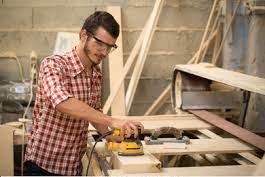 A joiner is a tradesperson or artisan who crafts things with wood, usually by joining pieces together. Joiner work is lighter than carpentry, and typically involves building things like furniture and the fittings of a house or ship. Many joiners are self-employed. The following are just a few of the jobs that a joiner might undertake. browse around this site Joiner Edinburgh – Edinburgh Joiner
A joiner is a tradesperson or artisan who crafts things with wood, usually by joining pieces together. Joiner work is lighter than carpentry, and typically involves building things like furniture and the fittings of a house or ship. Many joiners are self-employed. The following are just a few of the jobs that a joiner might undertake. browse around this site Joiner Edinburgh – Edinburgh Joiner
Apprenticeships are available in many different fields, and are open to people aged 16 and over. They work for a minimum of 30 hours a week and split their time between their training provider and their company. An apprenticeship is an excellent way to gain hands-on experience in construction. Initially, an apprentice may work as an assistant to a more experienced joiner. However, as their experience and abilities grow, they can progress into a supervisory or project management role.
Besides flattening boards, a joiner can also square two perpendicular sides. The key is to choose a jointer with blades that are dead-flush with the outfeed table. A larger jointer’s bed is also a better choice for longer boards. A longer bed means the board will be flatter than a shorter one.
Wood joinery is a crucial part of woodworking projects. It helps to create a solid structure and add aesthetic appeal. Whether you’re building a wooden chair or adding shelves to your bathroom, you’ll need joinery. The type of joinery you use will depend on the type of project and the tools you have available.
The skills of a joiner are essential for the construction of furniture, houses, and shops. This work involves connecting pieces of wood using a variety of methods, ranging from simple nailing and screwing to complicated joints. The main purpose of joinery is to hold pieces of wood together securely. However, it can also be used decoratively.
Wood joinery includes butt joints, mitre joints, and mortise and tenon joints. Butt joints are typically the simplest joints, and are suitable for small projects or pieces with limited movement. However, they are not very strong. Mitered butt joints are common in homes and are best for stationary joinery.
The difference between a joiner and a carpenter can sometimes cause confusion. Both professions use wood, and they are likely to share skills. While carpenters work on a construction site, joiners usually work in a workshop. If you’re looking for a career in a wood-based trade, consider a joiner.
In the construction industry, a joiner makes wooden products such as doors, windows, and stud-work. They may also install them on site. Their work is more complex and involves constructing items and making them fit. This type of construction is more expensive than ordinary jobs in other trades. They also typically produce items that have been created in a workshop.